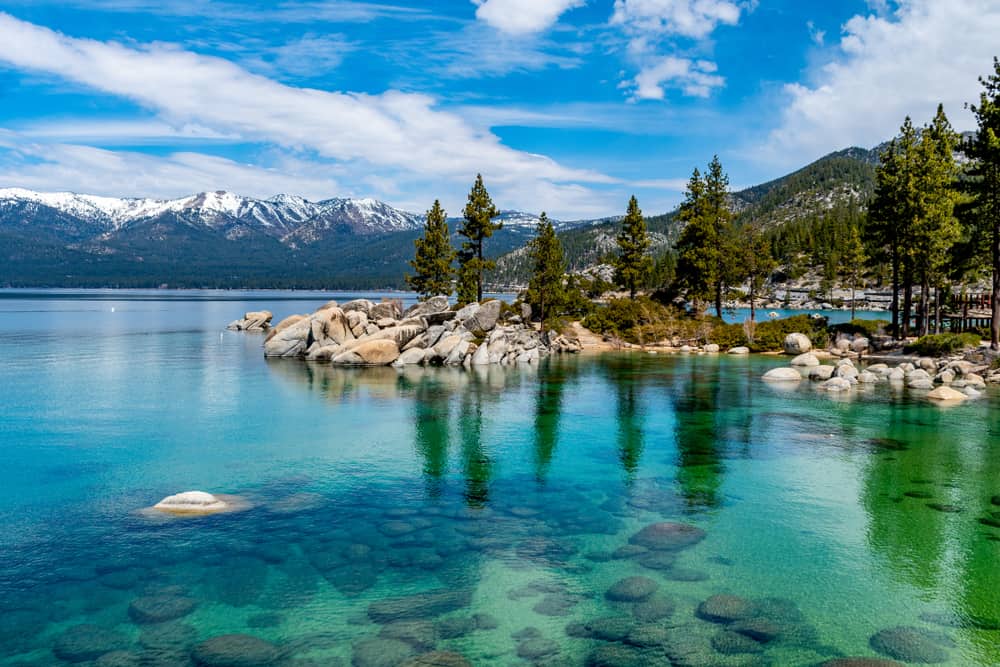Top ten vacation destinations in the US: Discovering the perfect getaway requires careful consideration. This exploration delves into a diverse range of locations, balancing objective criteria like accessibility and cost with subjective preferences for scenery and activities. From bustling cityscapes to tranquil natural wonders, we’ll uncover hidden gems and iconic landmarks, crafting an itinerary to suit every traveler’s unique needs and desires.
We’ll analyze various factors influencing the ranking, including geographic diversity, catering to different interests, budget considerations, seasonal appeal, and practicalities of travel. The result? A comprehensive guide to help you plan your next unforgettable American adventure.
Geographic Diversity
The United States boasts incredible geographic diversity, offering a vast array of vacation experiences across its expansive landscape. From sun-drenched beaches to snow-capped mountains, bustling cities to tranquil national parks, the country caters to every traveler’s preference. Exploring these diverse regions allows for a truly enriching and memorable travel experience, showcasing the unique character of each area.
Regional Vacation Destinations
The following table showcases ten distinct US regions and a representative vacation destination within each. These examples highlight the remarkable variety of landscapes and activities available across the country. The selection prioritizes regions with easily identifiable characteristics and popular tourist attractions.
| Region | Destination | Description |
|---|---|---|
| Northeast | Acadia National Park, Maine | Rugged coastline, granite peaks, and diverse wildlife make this park a stunning destination for hiking, scenic drives, and exploring the unique ecosystem of the Atlantic coast. |
| Southeast | Charleston, South Carolina | A historic city with charming architecture, rich Southern culture, and beautiful beaches nearby, offering a blend of history, culinary delights, and coastal relaxation. |
| Midwest | Yellowstone National Park, Wyoming (partially in the Midwest) | Famous for its geysers, hot springs, and abundant wildlife, Yellowstone offers breathtaking natural beauty and diverse outdoor activities. |
| Southwest | Grand Canyon National Park, Arizona | A colossal natural wonder, the Grand Canyon offers stunning views, hiking trails, and opportunities for exploring the unique geology and history of the region. |
| West Coast | San Francisco, California | A vibrant city known for its iconic landmarks, diverse neighborhoods, and proximity to stunning natural scenery, offering a blend of urban exploration and outdoor adventures. |
| Pacific Northwest | Olympic National Park, Washington | A diverse park featuring mountains, rainforests, and coastline, offering a unique blend of ecosystems and outdoor activities such as hiking, camping, and wildlife viewing. |
| Rocky Mountains | Aspen, Colorado | A renowned ski resort town offering world-class skiing in winter and stunning mountain scenery and outdoor activities in summer. |
| Great Plains | Badlands National Park, South Dakota | Dramatic landscapes of rugged canyons, spires, and buttes, offering hiking trails, scenic drives, and opportunities to observe diverse wildlife. |
| Alaska | Denali National Park, Alaska | Home to North America’s highest peak, Denali, the park offers incredible wilderness experiences, wildlife viewing, and opportunities for hiking and backpacking. |
| Hawaii | Maui, Hawaii | A tropical paradise known for its stunning beaches, volcanic landscapes, and lush rainforests, offering a variety of water sports, hiking, and cultural experiences. |
Budget Considerations
Planning a US vacation requires careful consideration of budget, as costs can vary significantly depending on the destination and travel style. This section details price ranges and value propositions for each of our top ten destinations, helping you choose a trip that fits your financial comfort level. We’ll examine accommodation costs, activity expenses, and other factors influencing the overall price.
Price Ranges and Factors Affecting Cost
The cost of a US vacation can range dramatically, from budget-friendly to luxurious. We’ve categorized our top ten destinations into low, mid, and high price ranges, based on average accommodation and activity costs for a week-long trip for two adults. These are estimates, and actual costs can fluctuate depending on the time of year, specific accommodations chosen, and individual spending habits.
| Destination | Price Range | Factors Affecting Cost |
|---|---|---|
| (Destination 1 – e.g., National Parks) | Low | Camping, budget-friendly lodging, free or low-cost activities (hiking, sightseeing). Food costs can be managed with self-catering. |
| (Destination 2 – e.g., New Orleans) | Mid | Moderate hotel/Airbnb costs, mix of affordable and pricier dining options, variety of activities ranging from free walking tours to paid attractions. Transportation costs moderate. |
| (Destination 3 – e.g., Hawaii) | High | Expensive flights and accommodation, high cost of dining and activities (water sports, tours). Transportation costs can be significant depending on island hopping. |
| (Destination 4 – e.g., New York City) | High | High accommodation costs, expensive dining and entertainment, cost of transportation within the city. Many free activities are available, but overall expenses tend to be high. |
| (Destination 5 – e.g., Orlando, Florida) | Mid-High | Moderate to high accommodation costs depending on proximity to theme parks. Theme park tickets are a significant expense. Food and transportation costs can be managed, but overall expenses can quickly escalate. |
| (Destination 6 – e.g., Yellowstone National Park) | Mid | Accommodation costs vary greatly (camping to lodges). Entrance fees apply, and gas costs for driving within the park are significant. Food costs can be managed with self-catering or budget-friendly options. |
| (Destination 7 – e.g., San Francisco) | High | High accommodation costs, expensive dining and entertainment. Transportation costs moderate to high. |
| (Destination 8 – e.g., Nashville, Tennessee) | Mid | Moderate accommodation and dining costs. Many free activities and affordable live music venues. Transportation costs moderate. |
| (Destination 9 – e.g., Charleston, South Carolina) | Mid | Moderate accommodation and dining costs. Variety of activities ranging from historical site visits to beach time. Transportation costs moderate. |
| (Destination 10 – e.g., Sedona, Arizona) | Mid-High | Accommodation costs can vary, from budget-friendly motels to luxury resorts. Many activities are outdoors-based and relatively affordable, but some tours and spas can be expensive. |
Value Proposition: Activities vs. Cost
The value of a vacation isn’t solely determined by price; the experience and activities available significantly influence overall satisfaction. The following chart illustrates a simplified representation of the value proposition for each destination, considering the range of activities available relative to the cost. Note that this is a subjective assessment, and individual preferences will influence perceived value.
| Destination | Cost (Low, Mid, High) | Activity Variety & Quality | Value Proposition (High, Medium, Low) |
|---|---|---|---|
| (Destination 1 – e.g., National Parks) | Low | High (hiking, wildlife viewing, scenic drives) | High |
| (Destination 2 – e.g., New Orleans) | Mid | High (music, food, history, culture) | High |
| (Destination 3 – e.g., Hawaii) | High | High (beaches, water sports, volcanoes) | Medium |
| (Destination 4 – e.g., New York City) | High | High (museums, Broadway, parks) | Medium |
| (Destination 5 – e.g., Orlando, Florida) | Mid-High | High (theme parks, entertainment) | Medium |
| (Destination 6 – e.g., Yellowstone National Park) | Mid | High (geysers, wildlife, hiking) | High |
| (Destination 7 – e.g., San Francisco) | High | High (Golden Gate Bridge, Alcatraz, diverse neighborhoods) | Medium |
| (Destination 8 – e.g., Nashville, Tennessee) | Mid | High (live music, honky-tonks, historical sites) | High |
| (Destination 9 – e.g., Charleston, South Carolina) | Mid | High (historic architecture, beaches, food) | High |
| (Destination 10 – e.g., Sedona, Arizona) | Mid-High | High (hiking, red rocks, spiritual experiences) | Medium |
Time of Year & Seasonal Appeal
Choosing the optimal time to visit a destination significantly impacts your experience. Weather conditions, crowd levels, and the availability of specific activities all fluctuate throughout the year. Understanding these seasonal variations allows for a more enjoyable and cost-effective trip. The following outlines the ideal travel times for each of our top ten destinations, considering these key factors.
Ideal Visit Times for Top US Destinations
The best time to visit each location depends on individual preferences for weather and crowds. Generally, shoulder seasons (spring and fall) often offer a sweet spot – pleasant weather with fewer tourists than peak summer months. However, specific events and festivals can influence ideal travel periods.
| Destination | Peak Season | Shoulder Season(s) | Off-Peak Season | Seasonal Highlights |
|---|---|---|---|---|
| Hawaii | December-March | April-May, September-November | June-August | Whale watching (winter), surfing competitions (various times), luaus (year-round) |
| Yellowstone National Park | June-August | May-June, September-October | November-April (Park mostly closed) | Geyser eruptions (year-round), wildlife viewing (summer & fall), hiking (summer & fall), winter snowmobiling (limited areas, permits required) |
| New York City | June-August, December-January | April-May, September-October | November (except Thanksgiving), February-March | Broadway shows (year-round), holiday markets (winter), outdoor concerts and events (summer), fashion week (fall) |
| Grand Canyon National Park | May-September | April-May, September-October | November-March | Hiking (summer & fall), mule rides (summer & fall), stargazing (year-round), winter snowshoeing (limited areas) |
| New Orleans | March-May, September-October | February, November | June-August, December-January | Mardi Gras (February/March), Jazz Fest (April/May), French Quarter Festival (April), Halloween celebrations (October) |
| National Parks (e.g., Yosemite, Zion, Glacier) | June-August | May-June, September-October | November-April (some areas closed) | Hiking (summer & fall), wildlife viewing (summer & fall), rock climbing (summer & fall), winter snowshoeing/skiing (limited areas, some parks offer winter activities) |
| San Francisco | July-September | May-June, October | November-April | Foggy weather (common throughout year), Golden Gate Bridge views (year-round), various festivals and events throughout the year. |
| Orlando, Florida | June-August, December-January | April-May, September-October | February-March, November | Theme park crowds peak during summer and holidays, special events throughout the year in theme parks. |
| Charleston, South Carolina | March-May, September-October | February, November | June-August, December-January | Historic architecture tours (year-round), Spoleto Festival USA (May/June), culinary scene (year-round). |
| Las Vegas, Nevada | March-May, September-October | February, November | June-August, December-January | Pool parties (summer), shows and concerts (year-round), numerous events and conventions throughout the year. |
Outcome Summary
Ultimately, the “best” US vacation destination is subjective, depending on individual preferences and travel styles. However, this exploration of the top ten destinations provides a robust framework for planning. By considering factors ranging from budget and accessibility to seasonal appeal and unique regional characteristics, travelers can confidently select a location that perfectly matches their vision of the ideal American escape. Remember to factor in personal preferences and research specific attractions within your chosen destination to maximize your enjoyment.




